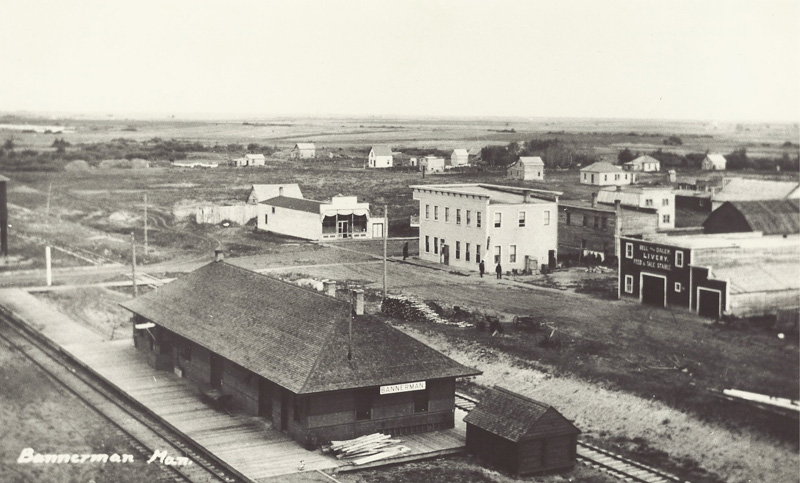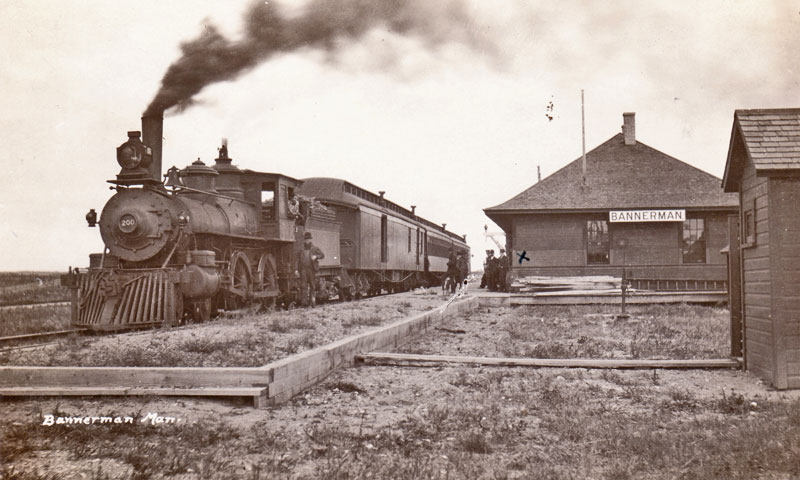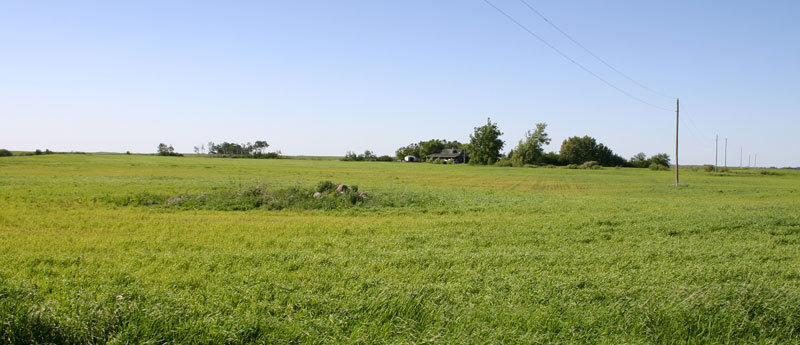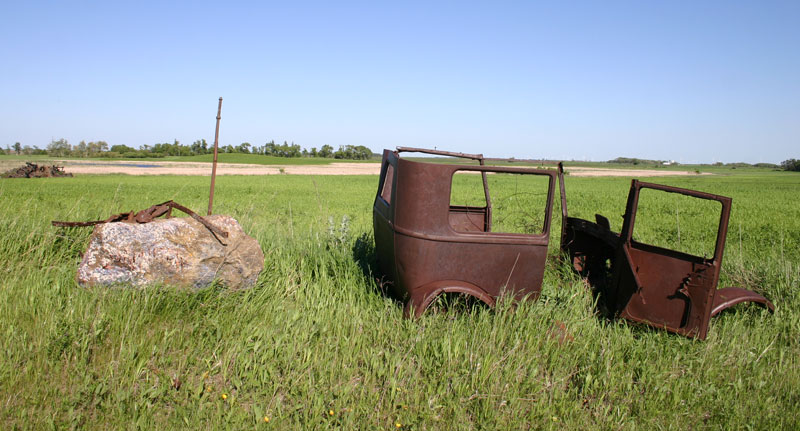| Index |
|
One Road Leads to Bannerman
Of all the newly created and boosted villages along the Great Northern line, the rise and fall of Bannerman was the most dramatic. The new rail line required a Port of Entry, naturally the first stop after a border crossing. A spot on NE 15-1-18, just about three kilometres north of the border, was suitable and available. Settlement in the area dates from around 1880 when James Henderson Sr. was the first settler to file in this vicinity. In 1905 as line approached, the town of Bannerman sprang into existence with excitement and a sense of possibility, the first and only port of entry by rail west of Emerson in Manitoba. The Manitoba Telegram ventured the opinion that it would become “ a good live town” and that “busy little centres will be established” at all the townsite points along the route. There was of course a rush to build homes, businesses and an elevator, and Bannerman quickly developed a boomtown atmosphere.  On
Main Street – near the station was the town’s most impressive building
– the hotel. . It was a large hotel with many rooms and a big dining
area as well as a bar for entertainment
In 1913 Mrs. Elizabeth Cook bought the hotel and boarding house beside it. When prohibition came, the bar was closed and it was then changed to a dance hall. South of the
hotel, Owen Bell and Gundar Hallen built and operated a
feed and livery barn. The livery stable to the right of the hotel
was owned and operated by Bill Cook who also supplied the community
with milk. There was a livery team and sleigh or buggy that was always
ready for hire. The lumber yard was owned by A. Bourassa from St. John.
On the same side of the street was the pool room and barber shop
operated by Bill Thompson. On the north part of town was a store and
post office, built by John Spafford in 1906. Joe Bate owned the first
blacksmith shop. Second owner was Mr. Balmoral. Jim Melville bought
this building and blacksmithed there for several years. J. Boupre owned
the harness and shoe repair shop.
Directly across the street from the hotel was another grocery store, built and owned by Frank Martineau in 1905. Jack Dickson and Sam Gibson also opened a store east of Martineau's. The store was bought and sold many times. Tom Blixhavn operated this store for many years. His sons farmed in the district.  There was a second blacksmith shop on the east side of the street. Andrew Henderson started the first store and butcher shop. This was later sold to Mr Jasper. They moved it to Wakopa and started the first beef ring in this area. Owners of the first Massey Harris dealership were Joe Bates and John Spafford. Doug Trevors also had an implement dealership in Bannerman. At some point a United Church was built in the village. The station's status as a port of entry meant that station had two offices, one for the railroad agent and one for the Customs and Immigration officer. These duties and responsibilities required other facilities and enhanced the status of the town. A detention house was soon added nearby for those who were not granted entry, and had to wait overnight for the train back. A quarantine barn was needed as all livestock was held overnight for inspection. To north of station were two section houses and a water tank.  Another added responsibility was controlling the flow of alcohol as different and changing liquor laws always seemed to keep make smuggling a worthwhile venture. Agents patrolled the border in the area. Then as now border security was an important responsibility. Magistrate John Balfour, aided by town cop Sam Balfour kept the peace locally. Each year the circus of the Royal Canadian Shows came by the Great Northern to entertain at Brandon summer fair. Customs agents went to Devil's Lake to start inspection of the many passenger cars and the inspection was completed at Bannerman. In 1904 One of the two McLaughlin-Buicks purchased by the "Royal "NWMP for border patrol was stationed in Boissevain, now a sub-district headquarters. Other detachments were at Bannerman and Cartwright. While the creation of the village happened quickly as was that of many other railway towns, the demise was also quite dramatic. Normally when a railway line was abandoned, smaller villages tended to continue their roles for a time. A store and a few services remained convenient for local farmers. The school might be kept. Some of those villages still exist decades after the elevator and train service ended. In the case of Bannerman, located as it was close to the border, there just wasn’t a customer base to keep it going. Wakopa still had a store and elevator. Boissevain and Killarney were’t all that far away for other purchases. So when the railway ceased operations in 1936, although the store moved in to the railways station and carried on for a while, the writing was on the wall. Bannerman Today   The faded lettering reads; “Bannerman Pop. 3” - that was some time ago. |
